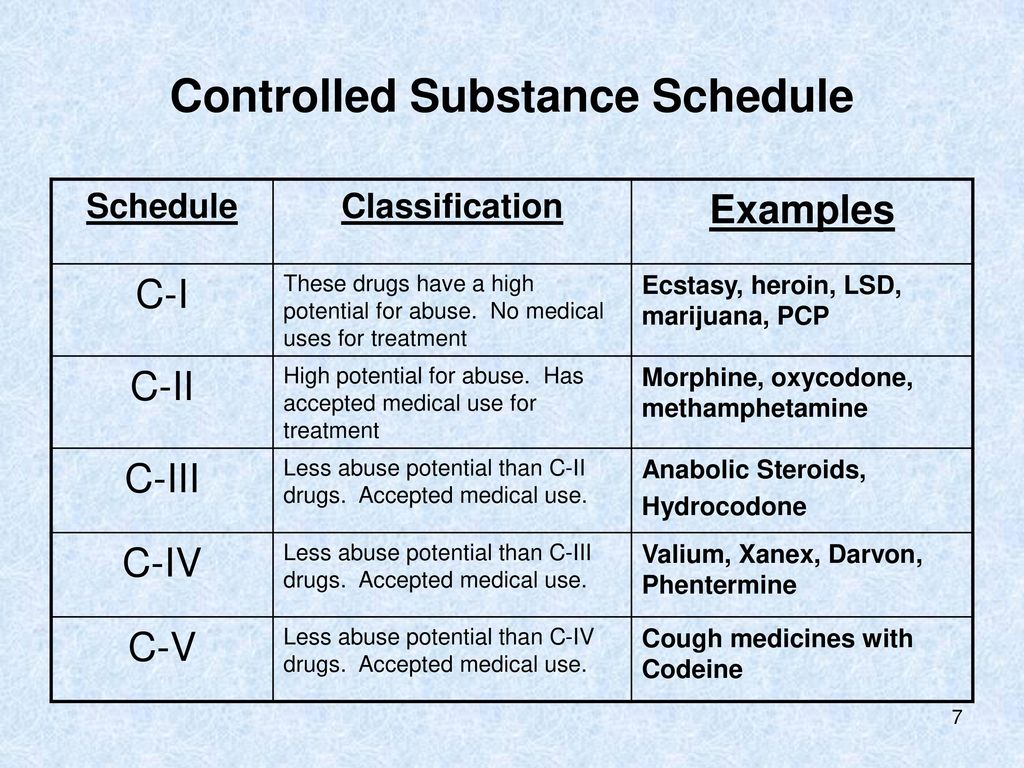Classification of Drugs: Understanding Drug Schedule I-V or Scheduele 1-5
U.S. controlled substances are grouped into five “schedules” that balance medical use with risks for abuse and dependence. Schedule I substances have no accepted medical use federally, while Schedules II–V do, with progressively lower abuse potential and lighter prescribing rules. Knowing where a medication sits helps explain why refills, ID checks, and pharmacy rules can feel strict—and how Overland IOP keeps patients safe.
What “drug schedule” means
The Drug Enforcement Administration (DEA) places drugs into Schedules I–V based on medical use, abuse potential, and risk of dependence. This classification drives how prescribers write, pharmacies dispense, and records are kept for safety and diversion prevention.
When it comes to understanding how drugs are regulated, knowing how they’re classified is key. In the world of pharmacology, drugs aren’t all treated equally —they’re divided into schedules based on factors like their medical use, potential for abuse, and risk of dependency.
These drug schedules (ranging from Schedule I to Schedule V) help shape how substances are prescribed, dispensed, and monitored. From the most tightly controlled to the least, each category plays an important role in balancing access to medications with public safety.

Schedule I Drugs or Scheduele 1 Drugs
Schedule 1 drugs are classified as substances with a high potential for abuse and no recognized medical use. These drugs are strictly regulated and illegal in most jurisdictions. Examples of Schedule 1 drugs include heroin, LSD, and ecstasy (MDMA). Due to their addictive properties and severe health risks, these substances are strictly prohibited and subject to stringent legal penalties.
Note: It is important to acknowledge that, while marijuana is classified as a Schedule 1 drug at the federal level in the United States, its legal status varies at the state level. Several states have legalized marijuana for medical and/or recreational use, which may create variations in its legal status and accessibility across different jurisdictions. It is essential to consult local laws and regulations regarding marijuana use and distribution in specific regions.
Schedule II Drugs or Scheduele 2 Drugs
Schedule 2 drugs possess a high potential for abuse but have accepted medical uses. They are subject to strict regulations, including limitations on prescriptions and dispensing. Substances in this schedule include powerful opioids such as oxycodone, morphine, and fentanyl, as well as stimulants like amphetamines. Due to their potential for addiction and misuse, these drugs are highly controlled and require careful monitoring and oversight.

Schedule III Drugs or Scheduele 3 Drugs
Schedule 3 drugs have a moderate potential for abuse but still possess accepted medical uses. Schedule 3 drugs require a prescription for legal acquisition, but the regulations governing them are relatively less stringent compared to those for Schedule 2 drugs. Examples of Schedule 3 substances include certain opioids with lower abuse potential, such as codeine preparations, as well as some anabolic steroids. These medications are subject to prescribing restrictions and monitoring to prevent abuse and ensure patient safety.
Schedule IV Drugs or Scheduele 4 Drugs
Schedule 4 drugs, also known as prescription-only medicines, have a moderate potential for abuse but hold significant therapeutic value. These drugs require a prescription from a healthcare professional for lawful acquisition and use. Schedule 4 substances include medications such as benzodiazepines (e.g., diazepam), certain opioids like tramadol, and sleep aids like zolpidem. While they have recognized medical uses, their potential for abuse necessitates regulation and controlled distribution.
Schedule V Drugs or Scheduele 5 Drugs
Schedule 5 drugs are classified as medications with a low potential for abuse or dependence. They have accepted medical uses and can be purchased without a prescription, albeit with some regulations in place. Schedule 5 substances have the lowest potential for abuse among controlled substances and are commonly used to treat mild conditions. Examples include medications containing low-dose codeine, diphenoxylate/atropine combinations, and certain antidiarrheal agents. While relatively safe, these drugs still require responsible use and adherence to recommended dosages.
Other Schedules & State-by-state differences
In addition to the schedules mentioned above, some countries or regions may have further classifications for controlled substances. These schedules are often jurisdiction-specific and aim to regulate substances based on their properties, potential for abuse, and medical uses. These additional schedules, such as Schedule 6 and higher, provide further categorization and legal frameworks specific to particular regions.
States can add controls or create additional categories beyond federal schedules, so availability and procedures (ID, quantity, pharmacist steps) may differ locally. Always follow your prescriber’s and pharmacist’s guidance.
Conclusion
Proper classification of drugs into different schedules provides a fundamental framework for regulating controlled substances based on their properties, potential for abuse, and medical uses. Understanding the distinctions between Schedule 1, Schedule 2, Schedule 3, Schedule 4, and Schedule 5 drugs is crucial for healthcare professionals, law enforcement agencies, policymakers, and individuals involved in the field of pharmacology.
FAQs
What’s the single biggest difference across schedules?
Medical use is recognized in Schedules II–V, but not in Schedule I. As you move from II → V, the abuse potential and restrictions generally decrease. DEADEA Diversion Control Division
Why can’t I refill my Schedule II prescription?
Federal law prohibits refills of Schedule II drugs; a new prescription is required each time. Your prescriber may issue multiple separate prescriptions to cover up to a 90-day supply when appropriate. DEA Diversion Control Division
How do refills work for Schedules III and IV?
If your prescriber authorizes them, pharmacies may dispense up to five refills within six months from the original date. After that, a new prescription is needed. eCFR
What about Schedule V refills?
Schedule V refills are allowed as authorized by the prescriber; state rules can add limits, so your pharmacy may advise specifics. PMC
Is cannabis still Schedule I?
Federally, yes—though state laws differ. A proposal to move cannabis to Schedule III is in play but not finalized as of August 2025; status could change with federal rulemaking. PBS
Why is tramadol listed with Schedule IV examples?
The DEA placed tramadol in Schedule IV in 2014 because of its misuse and dependence profile. Pharmacies must follow Schedule IV rules when dispensing it. Federal Register
Is pregabalin really controlled?
Yes—DEA placed pregabalin (Lyrica) into Schedule V in 2005 due to abuse potential, though it remains widely used therapeutically. Federal Register
Do schedules change?
They can. DEA can reschedule a substance based on new evidence. When that happens, prescribing/dispensing rules update accordingly (e.g., refills, e-prescription transfers). Federal Register
How do schedules affect my treatment at Overland IOP?
Scheduling informs how quickly we taper, which therapies we combine with medications, monitoring needs, and how we coordinate with your prescriber and pharmacy to reduce risks while maintaining access. (For program details, see your current page’s treatment sections.)


Prescription medication management is one of our valuable services at Overland IOP, a mental health and addiction treatment center. This service recognizes the significance of adhering to the appropriate drug schedules while ensuring the safe and responsible use of medications. By offering comprehensive treatment plans that encompass pharmacological interventions, Overland IOP aims to optimize patient care and promote long-term recovery. The classification of drugs by schedule serves as an important tool in promoting patient safety, preventing substance abuse, and facilitating appropriate access to medications. Through responsible prescribing practices, monitoring, and education, we can harness the power of pharmacology to improve lives and support individuals on their journey toward health and well-being.
Published: July 14, 2023
Last Updated: August 24, 2025

Published: September 29, 2025
Avoidant Personality Disorder (AvPD): Signs, Impact, and Paths to Healing
What if the problem isn’t that you don’t want connection—but that the cost of reaching for it feels unbearable? Avoidant Personality Disorder (AvPD) often hides in plain sight behind “I’m just shy” or “I’m fine on my own,” while a constant fear of criticism and rejection quietly shrinks work, friendships, even daily choices. You say […]
Read more
Published: September 28, 2025
What’s the Difference Between Psychologist and Therapist?
Not all mental health providers do the same work. This guide explains how psychologists differ from therapists (LMFT, LCSW, LPCC, etc.) in training and services and when to see each. What’s the Difference Between Psychologist and Therapist? When you’re ready to get help, the alphabet soup can be confusing: PhD, PsyD, LMFT, LCSW, LPCC, LPC, […]
Read more
Published: September 04, 2025
IOP Classes: What to Expect During IOP Program
In behavioral health, an Intensive Outpatient Program (IOP) delivers therapy on a set weekly schedule without an overnight stay. At Overland, adult IOP typically runs about 3–4 hours per day, 3–5 days per week, so you can keep work, school, and family responsibilities while getting more structure than standard once-weekly therapy. IOP programs or IOP […]
Read more
